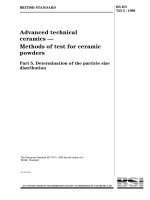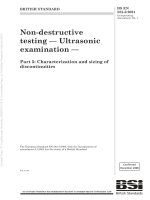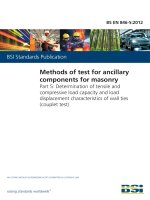Bsi bs en 62343 5 1 2015
Bạn đang xem bản rút gọn của tài liệu. Xem và tải ngay bản đầy đủ của tài liệu tại đây (1.2 MB, 22 trang )
BS EN 62343-5-1:2015
BSI Standards Publication
Dynamic modules
Part 5-1: Test methods — Dynamic
gain tilt equalizer — Gain tilt settling
time measurement
BRITISH STANDARD
BS EN 62343-5-1:2015
National foreword
This British Standard is the UK implementation of EN 62343-5-1:2015. It
is identical to IEC 62343-5-1:2014. It supersedes BS EN 62343-5-1:2009
which is withdrawn.
The UK participation in its preparation was entrusted by Technical
Committee GEL/86, Fibre optics, to Subcommittee GEL/86/3, Fibre optic
systems and active devices.
A list of organizations represented on this committee can be obtained on
request to its secretary.
This publication does not purport to include all the necessary provisions of
a contract. Users are responsible for its correct application.
© The British Standards Institution 2015.
Published by BSI Standards Limited 2015
ISBN 978 0 580 85310 4
ICS 33.180.01; 33.180.99
Compliance with a British Standard cannot confer immunity from
legal obligations.
This British Standard was published under the authority of the
Standards Policy and Strategy Committee on 31 March 2015.
Amendments/corrigenda issued since publication
Date
Text affected
EUROPEAN STANDARD
EN 62343-5-1
NORME EUROPÉENNE
EUROPÄISCHE NORM
March 2015
ICS 33.180.99; 33.180.01
Supersedes EN 62343-5-1:2009
English Version
Dynamic modules - Part 5-1: Test methods - Dynamic gain tilt
equalizer - Gain tilt settling time measurement
(IEC 62343-5-1:2014)
To be completed
(IEC 62343-5-1:2014)
Dynamische Module - Teil 5-1: Prüfverfahren - Equalizer
zur Kompensation einer dynamischen Verstärkerkennlinie Messung der Einstellzeit der Verstärkerschräglage
(IEC 62343-5-1:2014)
This European Standard was approved by CENELEC on 2014-12-30. CENELEC members are bound to comply with the CEN/CENELEC
Internal Regulations which stipulate the conditions for giving this European Standard the status of a national standard without any alteration.
Up-to-date lists and bibliographical references concerning such national standards may be obtained on application to the CEN-CENELEC
Management Centre or to any CENELEC member.
This European Standard exists in three official versions (English, French, German). A version in any other language made by translation
under the responsibility of a CENELEC member into its own language and notified to the CEN-CENELEC Management Centre has the
same status as the official versions.
CENELEC members are the national electrotechnical committees of Austria, Belgium, Bulgaria, Croatia, Cyprus, the Czech Republic,
Denmark, Estonia, Finland, Former Yugoslav Republic of Macedonia, France, Germany, Greece, Hungary, Iceland, Ireland, Italy, Latvia,
Lithuania, Luxembourg, Malta, the Netherlands, Norway, Poland, Portugal, Romania, Slovakia, Slovenia, Spain, Sweden, Switzerland,
Turkey and the United Kingdom.
European Committee for Electrotechnical Standardization
Comité Européen de Normalisation Electrotechnique
Europäisches Komitee für Elektrotechnische Normung
CEN-CENELEC Management Centre: Avenue Marnix 17, B-1000 Brussels
© 2015 CENELEC All rights of exploitation in any form and by any means reserved worldwide for CENELEC Members.
Ref. No. EN 62343-5-1:2015 E
BS EN 62343-5-1:2015
EN 62343-5-1:2015
-2-
Foreword
The text of document 86C/1249/CDV, future edition 2 of IEC 62343-5-1, prepared by SC 86C "Fibre
optic systems and active devices” of IEC/TC 86 “Fibre optics" was submitted to the IEC-CENELEC
parallel vote and approved by CENELEC as EN 62343-5-1:2015.
The following dates are fixed:
•
latest date by which the document has to be
implemented at national level by
publication of an identical national
standard or by endorsement
(dop)
2015-09-30
•
latest date by which the national
standards conflicting with the
document have to be withdrawn
(dow)
2017-12-30
This document supersedes EN 62343-5-1:2009.
This edition of EN includes the following significant technical changes with respect to the previous
edition:
a) change in the title;
b) changes in performance parameter names
Attention is drawn to the possibility that some of the elements of this document may be the subject of
patent rights. CENELEC [and/or CEN] shall not be held responsible for identifying any or all such
patent rights.
Endorsement notice
The text of the International Standard IEC 62343-5-1:2014 was approved by CENELEC as a
European Standard without any modification.
-3-
BS EN 62343-5-1:2015
EN 62343-5-1:2015
Annex ZA
(normative)
Normative references to international publications
with their corresponding European publications
The following documents, in whole or in part, are normatively referenced in this document and are
indispensable for its application. For dated references, only the edition cited applies. For undated
references, the latest edition of the referenced document (including any amendments) applies.
NOTE 1 When an International Publication has been modified by common modifications, indicated by (mod), the relevant
EN/HD applies.
NOTE 2 Up-to-date information on the latest versions of the European Standards listed in this annex is available here:
www.cenelec.eu.
Publication
IEC 62343
IEC 62343-1-3
Year
-
Title
EN/HD
Dynamic modules - General and guidance EN 62343
Dynamic modules -- Part 1-3: Performance EN 62343-1-3
standards - Dynamic gain tilt equalizer
(non-connectorized)
Year
-
–2–
BS EN 62343-5-1:2015
IEC 62343-5-1:2014 © IEC 2014
CONTENTS
1
Scope .............................................................................................................................. 6
2
Normative references ...................................................................................................... 6
3
Terms, definitions, abbreviations and response waveforms .............................................. 6
3.1
Terms and definitions .............................................................................................. 6
3.2
Abbreviations .......................................................................................................... 7
3.3
Response waveforms .............................................................................................. 7
4
General information ......................................................................................................... 8
5
Apparatus ........................................................................................................................ 9
5.1
Light source ............................................................................................................ 9
5.2
Pulse generator ...................................................................................................... 9
5.3
O/E converter ......................................................................................................... 9
5.4
Temperature and humidity chamber ...................................................................... 10
5.5
Oscilloscope ......................................................................................................... 10
5.6
Temporary joints ................................................................................................... 10
5.7
Control system ...................................................................................................... 10
5.8
Measurement setup .............................................................................................. 10
6
Procedure ...................................................................................................................... 11
6.1
Direct control type ................................................................................................. 11
6.1.1
Setup ............................................................................................................. 11
6.1.2
Preparation .................................................................................................... 11
6.1.3
Wavelength setting ........................................................................................ 12
6.1.4
Pulse generator setting .................................................................................. 12
6.1.5
Applying the driving pulse .............................................................................. 12
6.1.6
Monitoring and recording the output signal from DGTE under test (DUT) ....... 12
6.1.7
Calculation of the gain tilt settling time .......................................................... 12
6.2
Digital control type ................................................................................................ 12
6.2.1
Setup ............................................................................................................. 12
6.2.2
Preparation .................................................................................................... 12
6.2.3
Wavelength setting ........................................................................................ 12
6.2.4
Sending command ......................................................................................... 12
6.2.5
Monitoring and recording the command complete flag.................................... 13
6.2.6
Calculation of the gain tilt settling time .......................................................... 13
6.3
Analogue control type ........................................................................................... 13
6.3.1
Setup ............................................................................................................. 13
6.3.2
Preparation .................................................................................................... 13
6.3.3
Wavelength setting ........................................................................................ 13
6.3.4
Applying the control signal ............................................................................. 13
6.3.5
Monitoring and recording the command complete flag.................................... 13
6.3.6
Calculation of the gain tilt settling time .......................................................... 13
7
Details to be specified ................................................................................................... 13
7.1
Apparatus ............................................................................................................. 13
7.1.1
Light source ................................................................................................... 13
7.1.2
Pulse generator ............................................................................................. 14
7.1.3
O/E converter ................................................................................................ 14
7.1.4
Control system .............................................................................................. 14
BS EN 62343-5-1:2015
IEC 62343-5-1:2014 © IEC 2014
–3–
7.2
Measurement conditions ....................................................................................... 14
Annex A (informative) Convergence criterion ....................................................................... 15
Annex B (informative) Measurement examples..................................................................... 16
Annex C (informative) Gain tilt settling time for specific DGTEs ........................................... 17
Annex D (informative) Necessity for the correction for temperature dependency .................. 18
Figure 1 – Response waveforms for direct control DGTEs ...................................................... 7
Figure 2 – Response waveforms for digital control DGTEs ...................................................... 8
Figure 3 – Response waveforms for analogue control DGTEs ................................................. 8
Figure 4 – Measurement setup for direct control ................................................................... 10
Figure 5 – Measurement setup for digital control ................................................................... 11
Figure 6 – Measurement setup for analogue control .............................................................. 11
Figure B.1 – Where insertion loss change is sufficient .......................................................... 16
Figure B.2 – Where insertion loss change is small ................................................................ 16
Table 1 – Categorization of DGTE by the control method ....................................................... 9
–6–
BS EN 62343-5-1:2015
IEC 62343-5-1:2014 © IEC 2014
DYNAMIC MODULES –
Part 5-1 Test methods – Dynamic gain tilt equalizer –
Gain tilt settling time measurement
1
Scope
This part of IEC 62343 contains the measurement method of gain tilt settling time for a
dynamic gain tilt equalizer (DGTE) to change its gain tilt from an arbitrary initial value to a
desired target value.
2
Normative references
The following documents, in whole or in part, are normatively referenced in this document and
are indispensable for its application. For dated references, only the edition cited applies. For
undated references, the latest edition of the referenced document (including any
amendments) applies.
IEC 62343, Dynamic modules – General and guidance
IEC 62343-1-3, Dynamic modules – Part 1-3: Performance standards – Dynamic gain tilt
equalizer (non-connectorized)
3
3.1
Terms, definitions, abbreviations and response waveforms
Terms and definitions
For the purposes of this document, the terms and definitions given in IEC 62343 and
IEC 62343-1-3 and the following apply.
3.1.1
Tc
convergence time
time to converge from the first hit at the target ±Y % to the stay within the deviation ±Y % in
the optical power from the output port of DGTE at pre-determined wavelength
3.1.2
Tl
latency time
<direct and analogue control types> time between the application of control signal and the
change in output optical power by ±X % of the initial power of DGTE at pre-determined
wavelength
3.1.3
Tp
processing time
<digital control type> time between the application of control command and the change in
output optical power by ±X % of the initial power of DGTE at pre-determined wavelength
3.1.4
gain tilt settling time
(T l or T p ) + T r + T c
BS EN 62343-5-1:2015
IEC 62343-5-1:2014 © IEC 2014
–7–
3.1.5
Tr
rise time
time to change from the initial ±X % to the target ±Y % in the optical power from the output
port of DGTE at pre-determined wavelength
3.1.6
Ts
settling time
time to be suppressed from the first hit at the target ±Y % to the final stay at the target within
a required resolution of the optical power from the output port of DGTE at pre-determined
wavelength
3.2
Abbreviations
CPU
central processing unit
DGTE
dynamic gain tilt equalizer
DUT
device under test
LCD
liquid crystal display
O/E
optical-to-electrical
PDL
polarization dependent loss
TLS
tuneable laser source
WDM
wavelength division multiplexing
3.3
Response waveforms
The definitions and symbols defined in 3.1 are shown in Figure 1, Figure 2 and Figure 3.
Optical power
(W)
Po
100 + Y %
Target power
100 %
100 - Y %
Pu
Gain tilt settling time: T l + T r + T c
100 + X %
Initial power
100 %
100 - X %
Suppressed within
required resolution
Ts
Tl
Tr
Parameters
T l : Latency time
T r : Rise time
T c : Convergence time
T s : Settling time
P o : Overshoot
P u : Undershoot
Tc
Time
Control signal
IEC
Figure 1 – Response waveforms for direct control DGTEs
BS EN 62343-5-1:2015
IEC 62343-5-1:2014 © IEC 2014
–8–
Optical power (W)
100 + Y %
Target power
100 %
100 - Y %
Po
Pu
Parameters
T p : Processing time
T r : Rise time
T c : Convergence time
T s : Settling time
P o : Overshoot
P u : Undershoot
Gain tilt settling time: T p + T r + T c
100 + X %
Initial power
100 %
100 -
X%
Suppressed within
required resolution
Ts
Tp
Tr
Tc
Time
Command
IEC
Figure 2 – Response waveforms for digital control DGTEs
Optical power (W)
100 + Y %
Target power
100 %
100 - Y %
Po
Pu
Gain tilt settling time: T l + T r + T c
100 + X %
Initial power
100 %
100 - X %
Suppressed within
required resolution
Ts
Tl
Tr
Parameters
T l : Latency time
T r : Rise time
T c : Convergence time
T s : Settling time
P o : Overshoot
P u : Undershoot
Tc
Time
Control signal
IEC
Figure 3 – Response waveforms for analogue control DGTEs
4
General information
The DGTE is categorized into three control methods as shown in Table 1. The direct control
type is driven directly by voltage or current; the digital control type is operated by digital
control system with digital signals; and the analogue control type is operated by analogue
signals. The definition and the measurement method of gain tilt settling time for DGTE are
different for the three control types. Table 1 also shows the configuration of operating systems
and the correction for temperature dependency for three control types of DGTE. When the
gain tilt settling time for the DGTE has temperature dependency, users may need to calibrate
the temperature effect. The bottom row in Table 1 indicates the typical methods of the
correction for temperature dependency (refer to Annex D).
BS EN 62343-5-1:2015
IEC 62343-5-1:2014 © IEC 2014
–9–
Table 1 – Categorization of DGTE by the control method
Direct control
Control
By voltage or current
directly
Configurations
V/I applied
Control system
5
5.1
By command through digital
circuit
DGTE
w/digital circuit
DGTE
Correction for
temperature
dependency
Digital control
By control system
Command
(Rs232c, I2C, etc.)
Control system
By digital circuit or control
system
Analogue control
By voltage or current
through analogue circuit
DGTE
w/analogue circuit
V/I control
(ex.0~+5V)
Control system
By analogue circuit or
control system
Apparatus
Light source
A tuneable wavelength device is used as the light source. A tuneable laser source (TLS) or a
combination of a broadband light source and tuneable filter is the typical equipment of
tuneable wavelength light source. The tuning range of the tuneable wavelength light source
shall be enough to cover the operating wavelength of DGTE to be measured.
In order to minimise the measurement uncertainty caused by the linewidth of the light source,
the linewidth multiplied by the maximum value of the gain tilt slope of DGTE shall be smaller
than one tenth of the dynamic gain tilt range. Typical value of operating wavelength range and
dynamic gain tilt range of DGTE are 35 nm and ±4 dB respectively. For example, the error for
the linewidth of 1 nm is calculated as:
4 / 35
1×
= 1,4%
[+ 4 − ( −4)]
(1)
The output power of the light source shall remain stable during the measurement. The stability
of the output power during the gain tilt settling time of DGTE to be measured shall be smaller
than one tenth of dynamic gain tilt range of DGTE.
If the polarization dependent loss (PDL) of DGTE to be measured is larger than 0,5 dB, a
depolarized light source shall be used.
5.2
Pulse generator
A pulse generator is used to drive DGTE to be measured. The shape of the pulse shall be
rectangular to change the gain tilt. The intensity and width of the pulse shall be such to make
the maximum tilt change defined as the specification of DGTE. The rise time/fall time of the
rectangular pulse shall be shorter than 10 ns or one tenth of the rise time/fall time to be
measured.
5.3
O/E converter
An O/E converter is used to convert the optical output power of DGTE to be measured to the
electrical power to be observed by an oscilloscope. The bandwidth of O/E converter shall be
from DC to greater than 10(1/T r ) Hz, where T r is the rise time to be measured.
– 10 –
BS EN 62343-5-1:2015
IEC 62343-5-1:2014 © IEC 2014
The maximum power input to the O/E converter before compression shall be 10 times more
than the optical power to be measured.
5.4
Temperature and humidity chamber
The test setup shall include an environmental chamber capable of producing and maintaining
the specified temperature and/or humidity.
5.5
Oscilloscope
The oscilloscope shall have a storage function and sufficient bandwidth and accuracy. It shall
have at least two traces.
5.6
Temporary joints
This is a method, device, or mechanical fixture for temporarily aligning two fibre ends into a
reproducible, low loss joint. It may be, for example, a precision V-groove vacuum chuck,
micromanipulator or a fusion or mechanical splice. The stability of the temporary joint shall be
compatible with the measurement precision required.
5.7
Control system
For the digital and the analogue control types, the control system is used to drive the DGTE.
The specification is defined individually.
5.8
Measurement setup
The measurement setups for the three types of DGTE in Table 1 are shown in Figure 4,
Figure 5 and Figure 6, respectively. For each type of control, a correction signal from the O/E
converter output is applied to the DGTE.
Chamber
Light source
DGTE
Oscilloscope
Oscilloscope
O/E
converter
Pulse generator
Signal pulse
IEC
Figure 4 – Measurement setup for direct control
BS EN 62343-5-1:2015
IEC 62343-5-1:2014 © IEC 2014
– 11 –
Oscilloscope
Chamber
O/E
converter
DGTE
w/digital circuit
Light source
Command
RS232c
GP-IB
I2C
Dual port RAM
etc.
Command complete flag
Control system
Command sending flag
IEC
NOTE
Either command complete flag or command sending flag can be used
Figure 5 – Measurement setup for digital control
Oscilloscope
Oscilloscope
Chamber
O/E
converter
DGTE
w/analogue circuit
Light source
Voltage
or
current
Control system
NOTE
Command complete flag
IEC
The control system provides a step signal to the DGTE.
Figure 6 – Measurement setup for analogue control
6
Procedure
6.1
6.1.1
Direct control type
Setup
The measurement setup is shown in Figure 4. The temperature after setting shall be kept
stabilized and uniform in the chamber for the stable measurement. The light source, the pulse
generator, the O/E converter and the oscilloscope shall be turned on for the measurement.
6.1.2
Preparation
Before starting the measurement, the setup shall be held constant for more than 1 h for
stabilization.
– 12 –
6.1.3
BS EN 62343-5-1:2015
IEC 62343-5-1:2014 © IEC 2014
Wavelength setting
The wavelength of the light source shall be set at the measuring wavelength. The
measurement shall take place at three wavelengths: shortest, centre and longest wavelengths
in the operating wavelength range. An alternative method is to measure at the wavelength at
the maximum deviation in insertion loss.
6.1.4
Pulse generator setting
The voltage or current to drive from the minimum (maximum) tilt to maximum (minimum) shall
be set. The minimum and the maximum states of tilt occur when the deviation in insertion loss
takes the maximum value at the shortest or the longest wavelength within the operating
wavelength.
6.1.5
Applying the driving pulse
The driving pulse shall be applied to the DGTE to be measured by the pulse generator.
6.1.6
Monitoring and recording the output signal from DGTE under test (DUT)
The output signal from the O/E converter shall be monitored by the oscilloscope and the data
shall be recorded. In addition, the signal pulse from the pulse generator shall be monitored
and recorded.
6.1.7
Calculation of the gain tilt settling time
After the measurement at three wavelengths, the gain tilt settling time shall be calculated
according to Figure 1. Generally, the gain tilt settling time is defined as the maximum value
among the three gain tilt settling times.
6.2
6.2.1
Digital control type
Setup
The measurement setup is shown in Figure 5. The temperature after setting shall be kept
stabilized and uniform in the chamber for the stable measurement. The light source, the
digital control system, the O/E converter and the oscilloscope shall be turned on for the
measurement.
6.2.2
Preparation
Before starting the measurement, the setup shall be turned on for more than 1 h for
stabilization.
6.2.3
Wavelength setting
The wavelength of the light source shall be set at the measuring wavelength. The
measurement shall take place at three wavelengths: shortest, centre and longest in the
operating wavelength range. An alternative method is to measure at the wavelength at the
maximum deviation in insertion loss.
6.2.4
Sending command
The command to operate from the minimum (maximum) tilt to maximum (minimum) shall be
set. The minimum and the maximum states of tilt are given when the deviation in insertion
loss takes the maximum value at the shortest or the longest wavelength within the operating
wavelength. After the setting, the command shall be sent from the control system.
BS EN 62343-5-1:2015
IEC 62343-5-1:2014 © IEC 2014
6.2.5
– 13 –
Monitoring and recording the command complete flag
The output signal from the O/E converter and the command complete flag from the DUT shall
be monitored by the oscilloscope and the data shall be recorded. The command sending flag
from the control system, which may be substituted for the command complete flag from DUT if
not available, shall also be monitored and recorded.
6.2.6
Calculation of the gain tilt settling time
After the measurement at three wavelengths, the gain tilt settling time is calculated according
to Figure 2. Generally, the gain tilt settling time is defined as the maximum value among the
three gain tilt settling times.
6.3
Analogue control type
6.3.1
Setup
The measurement setup is as shown in Figure 5. The temperature shall be kept stabilized and
constant in the chamber for the measurement. The light source, the analogue control system,
O/E converter and oscilloscope shall be turned on for the measurement.
6.3.2
Preparation
Before starting the measurement, the setup shall be turned on for more than 1 h for
stabilization.
6.3.3
Wavelength setting
The wavelength of the light source shall be set at the measuring wavelength. The
measurement shall take place at three wavelengths: shortest, centre and longest wavelengths
in the operating wavelength range. An alternative method is to measure at the wavelength at
the maximum deviation in insertion loss.
6.3.4
Applying the control signal
The control signal to operate from the minimum (maximum) tilt to maximum (minimum) tilt
shall be set. The minimum and the maximum states of tilt occur when the deviation in
insertion loss takes the maximum value at the shortest or the longest wavelength within the
operating wavelength. After the setting, the signal shall be sent from the control system.
6.3.5
Monitoring and recording the command complete flag
The output signal from the O/E converter shall be monitored by the oscilloscope and the data
recorded. Also, the command complete flag from the control system shall be monitored and
recorded.
6.3.6
Calculation of the gain tilt settling time
The gain tilt settling time is calculated according to Figure 3. After the measurement at three
wavelengths, the gain tilt settling time is calculated. Generally, the gain tilt settling time is
defined as the maximum value among the three gain tilt settling times.
7
Details to be specified
7.1
7.1.1
Apparatus
Light source
These characteristics of the light source shall be specified:
– 14 –
–
spectral width
–
state of polarization
–
output power
7.1.2
BS EN 62343-5-1:2015
IEC 62343-5-1:2014 © IEC 2014
Pulse generator
These characteristics of the pulse generator shall be specified:
–
rising time
–
pulse width
–
pulse intensity
7.1.3
O/E converter
These characteristics of the O/E convertor shall be specified:
–
response frequency
–
dynamic range
7.1.4
Control system
These characteristics of the control system shall be specified:
–
type of control system
–
type of interface
7.2
Measurement conditions
These measurement conditions shall be specified:
–
wavelength
–
deviation of tilt
–
insertion loss deviation at the measuring wavelength
–
temperature of chamber
–
tolerance of target insertion loss deviation
BS EN 62343-5-1:2015
IEC 62343-5-1:2014 © IEC 2014
– 15 –
Annex A
(informative)
Convergence criterion
A DGTE used in an optical amplifier converts input signals with time-varying gain tilt into
output signals in which gain tilt is nominally flat. A required flatness for multichannel EDFAs
for WDM systems is typically ±0,5 dB for each spectral band. Therefore, the gain tilt settling
time of the DGTE is recommended to be defined as the convergence to ±0,5 dB [≅(±10 %)]
from target attenuation.
– 16 –
BS EN 62343-5-1:2015
IEC 62343-5-1:2014 © IEC 2014
Annex B
(informative)
Measurement examples
Two examples are shown below in Figure B.1 and Figure B.2. In the case where the insertion
loss change is small and the target power is within ± 10 % of the initial power at the measured
wavelength, the gain tilt settling time cannot be defined as in Figure B.2.
Current power
0,0 dBm (1,00 mW)
90 % of current power
-0,5 dBm (0,90 mW)
-3,0 dB attenuation
110 % of target power
-2,6 dBm (0,55 mW)
Target power
-3,0 dBm (0,50 mW)
90 % of target power
-3,5 dBm (0,45 mW)
Command
Tp
Tr
Tc
Gain tilt settling time
IEC
Initial optical power: 0 dB m (1,0 mW)
Target optical power: -3 dBm (0,5 mW)
Target attenuation: -3 Db
Figure B.1 – Where insertion loss change is sufficient
110 % of target power
-4,9 dBm (0,33 mW)
Current power
-5,0 dBm (0,32 mW)
-0,3 dB attenuation
Target power
-5,3 dBm (0,30 mW)
90 % of current power
-5,5 dBm (0,28 mW)
90 % of target power
-5,8 dBm (0,27 mW)
Command
-0,5 dBm (0,90 mW)
Gain tilt settling time cannot be defined
Initial optical power: -5,0 dBm (0,32 mW)
Target optical power: -5,3 dBm (0,30 mW)
Target attenuation: -0,3 dB
Figure B.2 – Where insertion loss change is small
IEC
BS EN 62343-5-1:2015
IEC 62343-5-1:2014 © IEC 2014
– 17 –
Annex C
(informative)
Gain tilt settling time for specific DGTEs
Gain tilt settling time is defined as the maximum value over operating temperature range. An
LCD (liquid crystal device) may show longer gain tilt settling time at low temperature.
– 18 –
BS EN 62343-5-1:2015
IEC 62343-5-1:2014 © IEC 2014
Annex D
(informative)
Necessity for the correction for temperature dependency
The gain tilt settling time of the DGTE may depend on ambient temperature. Some devices
have a temperature controller in the package. Some devices have a temperature
compensation function to compensate the temperature dependence by tuning the applied
voltage or the current according to an ambient temperature. The correction for the direct
control type shall be done by a control system at a higher level. The digital control type of
DGTE has a CPU and monitors an ambient temperature to correct the temperature effect by
itself. The analogue control type also has an analogue circuit and monitors an ambient
temperature to correct the temperature effect by itself.
_____________
This page deliberately left blank
NO COPYING WITHOUT BSI PERMISSION EXCEPT AS PERMITTED BY COPYRIGHT LAW
British Standards Institution (BSI)
BSI is the national body responsible for preparing British Standards and other
standards-related publications, information and services.
BSI is incorporated by Royal Charter. British Standards and other standardization
products are published by BSI Standards Limited.
About us
Revisions
We bring together business, industry, government, consumers, innovators
and others to shape their combined experience and expertise into standards
-based solutions.
Our British Standards and other publications are updated by amendment or revision.
The knowledge embodied in our standards has been carefully assembled in
a dependable format and refined through our open consultation process.
Organizations of all sizes and across all sectors choose standards to help
them achieve their goals.
Information on standards
We can provide you with the knowledge that your organization needs
to succeed. Find out more about British Standards by visiting our website at
bsigroup.com/standards or contacting our Customer Services team or
Knowledge Centre.
Buying standards
You can buy and download PDF versions of BSI publications, including British
and adopted European and international standards, through our website at
bsigroup.com/shop, where hard copies can also be purchased.
If you need international and foreign standards from other Standards Development
Organizations, hard copies can be ordered from our Customer Services team.
Subscriptions
Our range of subscription services are designed to make using standards
easier for you. For further information on our subscription products go to
bsigroup.com/subscriptions.
With British Standards Online (BSOL) you’ll have instant access to over 55,000
British and adopted European and international standards from your desktop.
It’s available 24/7 and is refreshed daily so you’ll always be up to date.
You can keep in touch with standards developments and receive substantial
discounts on the purchase price of standards, both in single copy and subscription
format, by becoming a BSI Subscribing Member.
PLUS is an updating service exclusive to BSI Subscribing Members. You will
automatically receive the latest hard copy of your standards when they’re
revised or replaced.
To find out more about becoming a BSI Subscribing Member and the benefits
of membership, please visit bsigroup.com/shop.
With a Multi-User Network Licence (MUNL) you are able to host standards
publications on your intranet. Licences can cover as few or as many users as you
wish. With updates supplied as soon as they’re available, you can be sure your
documentation is current. For further information, email
BSI Group Headquarters
389 Chiswick High Road London W4 4AL UK
We continually improve the quality of our products and services to benefit your
business. If you find an inaccuracy or ambiguity within a British Standard or other
BSI publication please inform the Knowledge Centre.
Copyright
All the data, software and documentation set out in all British Standards and
other BSI publications are the property of and copyrighted by BSI, or some person
or entity that owns copyright in the information used (such as the international
standardization bodies) and has formally licensed such information to BSI for
commercial publication and use. Except as permitted under the Copyright, Designs
and Patents Act 1988 no extract may be reproduced, stored in a retrieval system
or transmitted in any form or by any means – electronic, photocopying, recording
or otherwise – without prior written permission from BSI. Details and advice can
be obtained from the Copyright & Licensing Department.
Useful Contacts:
Customer Services
Tel: +44 845 086 9001
Email (orders):
Email (enquiries):
Subscriptions
Tel: +44 845 086 9001
Email:
Knowledge Centre
Tel: +44 20 8996 7004
Email:
Copyright & Licensing
Tel: +44 20 8996 7070
Email:









